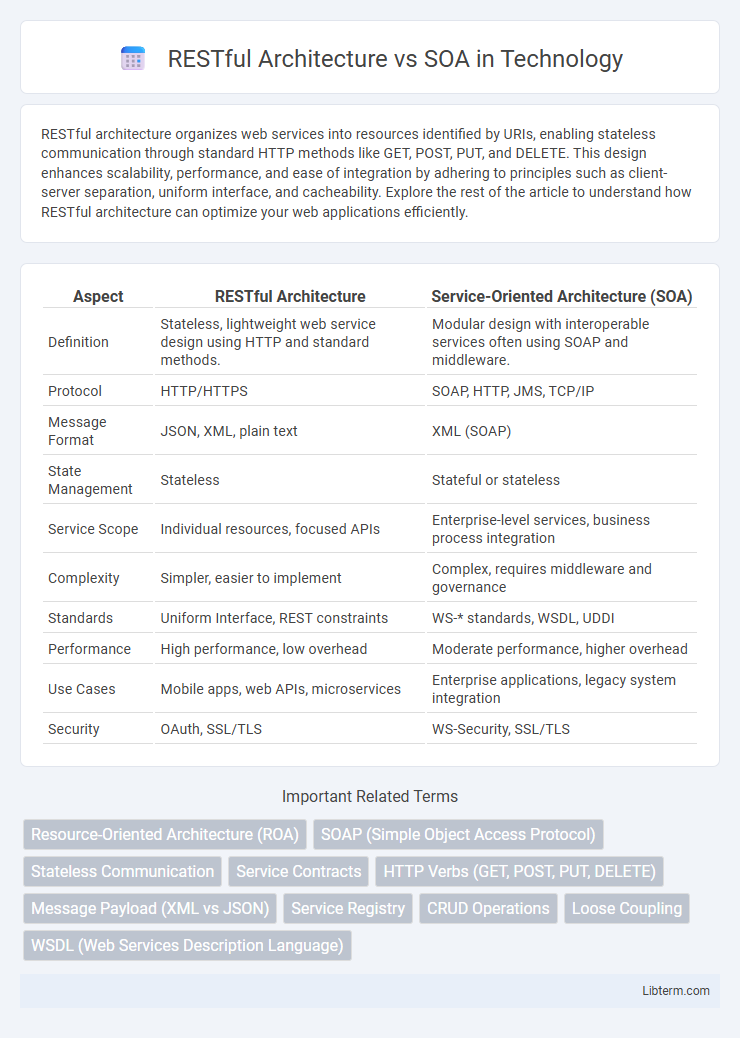RESTful architecture organizes web services into resources identified by URIs, enabling stateless communication through standard HTTP methods like GET, POST, PUT, and DELETE. This design enhances scalability, performance, and ease of integration by adhering to principles such as client-server separation, uniform interface, and cacheability. Explore the rest of the article to understand how RESTful architecture can optimize your web applications efficiently.
Table of Comparison
| Aspect | RESTful Architecture | Service-Oriented Architecture (SOA) |
|---|---|---|
| Definition | Stateless, lightweight web service design using HTTP and standard methods. | Modular design with interoperable services often using SOAP and middleware. |
| Protocol | HTTP/HTTPS | SOAP, HTTP, JMS, TCP/IP |
| Message Format | JSON, XML, plain text | XML (SOAP) |
| State Management | Stateless | Stateful or stateless |
| Service Scope | Individual resources, focused APIs | Enterprise-level services, business process integration |
| Complexity | Simpler, easier to implement | Complex, requires middleware and governance |
| Standards | Uniform Interface, REST constraints | WS-* standards, WSDL, UDDI |
| Performance | High performance, low overhead | Moderate performance, higher overhead |
| Use Cases | Mobile apps, web APIs, microservices | Enterprise applications, legacy system integration |
| Security | OAuth, SSL/TLS | WS-Security, SSL/TLS |
Introduction to RESTful Architecture and SOA
RESTful Architecture is an architectural style for designing networked applications using stateless, client-server communication over HTTP, emphasizing scalability and simplicity through uniform interfaces and resources identified by URIs. Service-Oriented Architecture (SOA) organizes distributed computing resources as interoperable services with well-defined interfaces, aiming to enhance business process integration by promoting reusable, loosely coupled components. REST focuses on resource-based interactions and lightweight protocols, while SOA prioritizes complex service orchestration and enterprise-level system integration.
Core Principles of RESTful Architecture
RESTful Architecture emphasizes stateless communication, resource-based interactions via URIs, and the use of standard HTTP methods such as GET, POST, PUT, and DELETE to perform CRUD operations on resources. It promotes scalability and simplicity by adhering to a uniform interface, enabling decoupled client-server interactions through representations of resources exchanged over a network. In contrast, SOA focuses on modular services with well-defined contracts, often leveraging complex messaging protocols, whereas REST prioritizes lightweight, web-standard protocols optimized for scalability and performance.
Fundamental Concepts of Service-Oriented Architecture (SOA)
Service-Oriented Architecture (SOA) centers on designing software systems as a collection of interoperable services that communicate over a network using standard protocols, allowing for loose coupling and reusability. Fundamental concepts of SOA include service abstraction, service contract, service composition, and service autonomy, which promote modular design and enable scalable, flexible business processes. Unlike RESTful Architecture, which primarily focuses on stateless communication and resource manipulation via HTTP methods, SOA emphasizes orchestrating complex workflows and integrating heterogeneous enterprise applications through standardized messaging patterns like SOAP and XML.
Key Differences Between RESTful Architecture and SOA
RESTful architecture emphasizes stateless communication using standard HTTP methods and resource-based URIs, promoting simplicity and scalability for web services. SOA (Service-Oriented Architecture) focuses on loosely coupled, reusable services often communicating through complex messaging protocols like SOAP and XML, prioritizing interoperability across heterogeneous systems. The key differences lie in REST's lightweight, resource-centric design versus SOA's heavyweight, contract-driven approach supporting enterprise-wide integration.
Communication Protocols in RESTful Architecture vs SOA
RESTful architecture primarily uses HTTP as its communication protocol, leveraging standard methods like GET, POST, PUT, and DELETE for resource manipulation. SOA supports multiple communication protocols including HTTP, SOAP, JMS, and others, allowing for more flexible but complex integration scenarios. The simplicity and stateless nature of HTTP in REST contrasts with the protocol-agnostic and often stateful communication found in SOA implementations.
Scalability and Flexibility Comparison
RESTful architecture enhances scalability by leveraging stateless communication and caching mechanisms, allowing distributed systems to handle increased loads efficiently. SOA offers flexibility through service abstraction and loose coupling, enabling diverse services to interoperate across platforms, but can introduce complexity that affects scalability. REST's lightweight protocols often result in higher performance and easier horizontal scaling compared to the typically heavier SOAP-based SOA implementations.
Security Considerations: RESTful Architecture vs SOA
RESTful architecture emphasizes statelessness and uses standard HTTP methods, making security reliant on protocols like TLS for encryption and OAuth for authentication. SOA incorporates more complex security mechanisms, including WS-Security standards that support message-level encryption, digital signatures, and granular access control. The choice between RESTful and SOA security depends on the need for lightweight communication versus comprehensive, end-to-end secure message exchanges.
Real-world Use Cases for RESTful and SOA
RESTful architecture excels in lightweight web services, enabling scalable interactions for social media platforms like Twitter and Facebook, where stateless communication and resource-based APIs enhance performance and flexibility. SOA is preferred in enterprise environments such as banking systems and telecommunications, where complex, reusable services and interoperability across heterogeneous systems are critical for integrating legacy applications and ensuring robust service orchestration. Both architectures serve distinct real-world requirements: RESTful is optimal for mobile and web applications requiring low latency, while SOA supports large-scale, distributed business processes demanding high reliability and governance.
Advantages and Disadvantages of RESTful Architecture and SOA
RESTful architecture offers simplicity, scalability, and stateless communication, making it highly suitable for web services with lightweight data exchange; however, it lacks built-in standards for security and transactions compared to SOA. SOA provides robust support for complex business processes, reliable messaging, and integrated security features, facilitating interoperability across diverse systems, but it tends to be more complex, costly, and harder to maintain. Selecting RESTful architecture suits scenarios prioritizing fast, scalable interactions, while SOA fits enterprise environments demanding rigorous service governance and orchestration.
Choosing the Right Architecture for Your Business Needs
RESTful architecture offers lightweight, scalable web services ideal for mobile and web applications requiring stateless interactions and rapid performance. SOA provides a more robust, enterprise-level framework suited for complex integrations, supporting multiple protocols and reusable services across diverse business processes. Selecting between RESTful and SOA depends on factors like system complexity, interoperability needs, scalability demands, and existing infrastructure.
RESTful Architecture Infographic

 libterm.com
libterm.com